人教版(2019)必修第二册Unit 4 History and Traditions文化拓展课件-(50张ppt)
文档属性
| 名称 | 人教版(2019)必修第二册Unit 4 History and Traditions文化拓展课件-(50张ppt) | 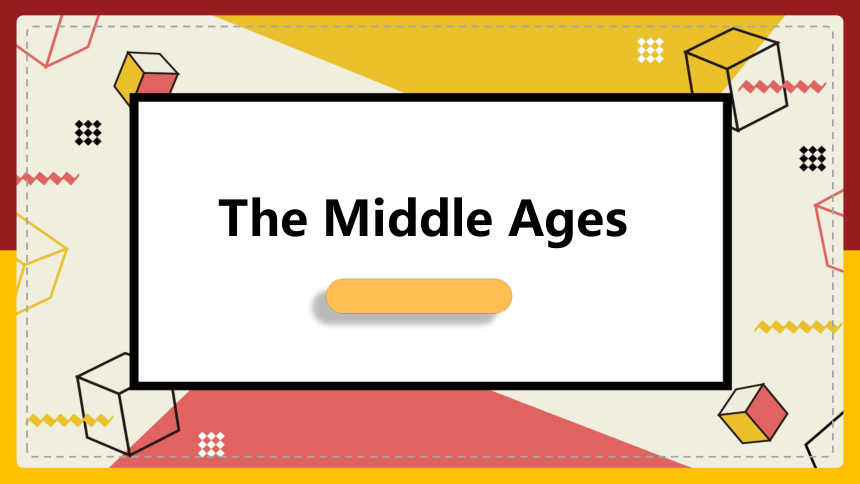 | |
| 格式 | pptx | ||
| 文件大小 | 12.1MB | ||
| 资源类型 | 教案 | ||
| 版本资源 | 人教版(2019) | ||
| 科目 | 英语 | ||
| 更新时间 | 2022-11-02 23:35:17 | ||
图片预览


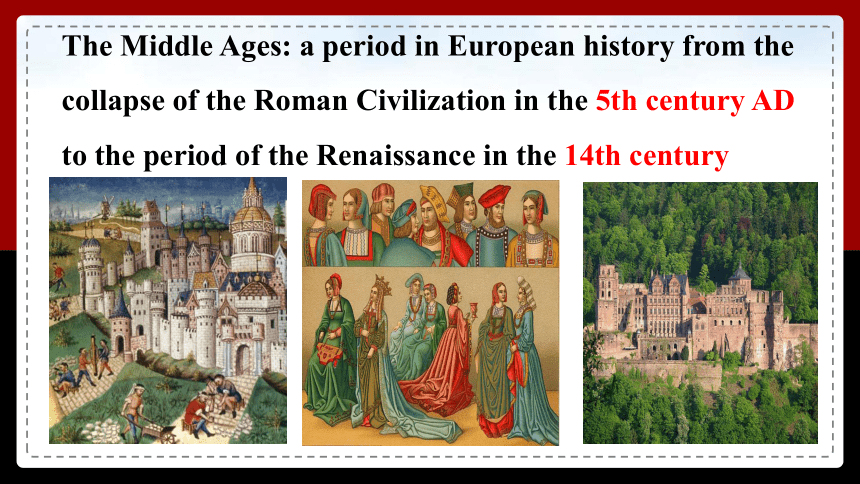

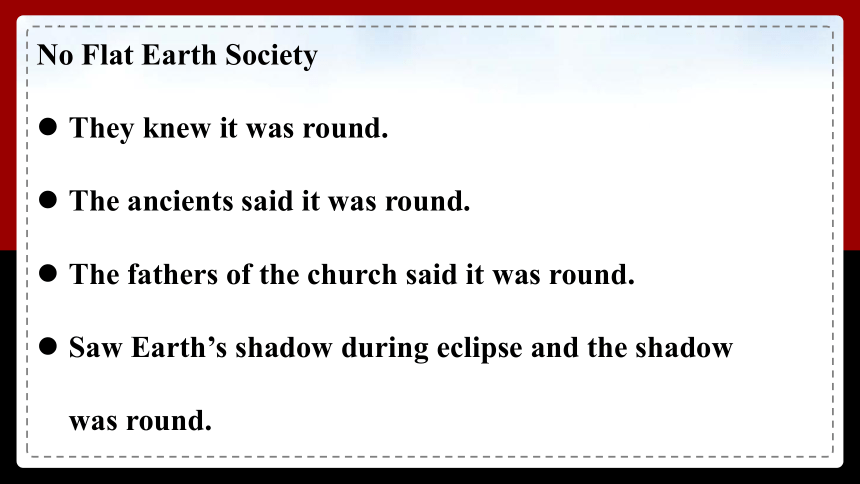
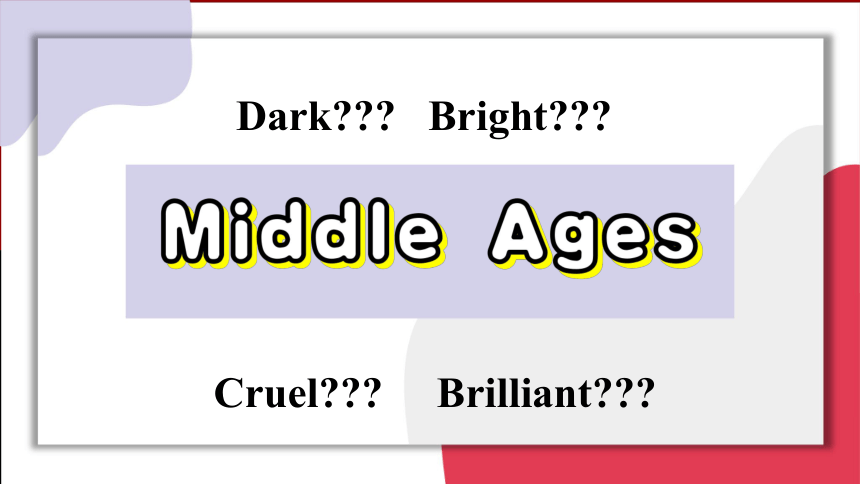
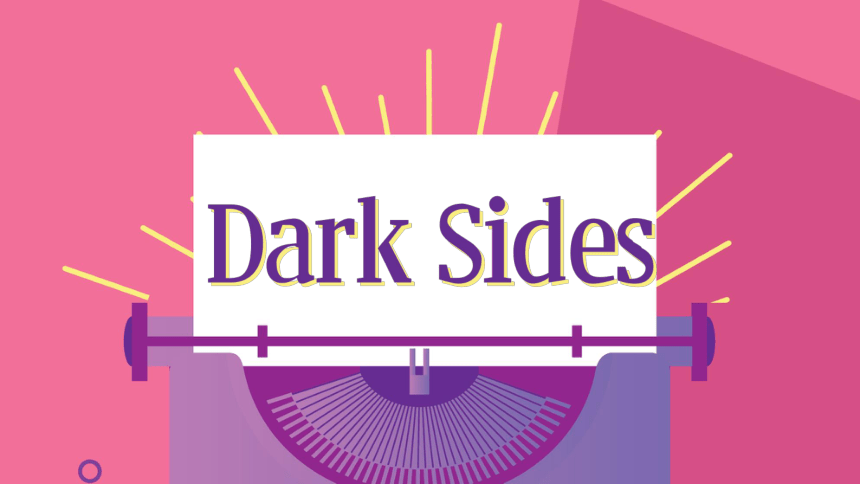

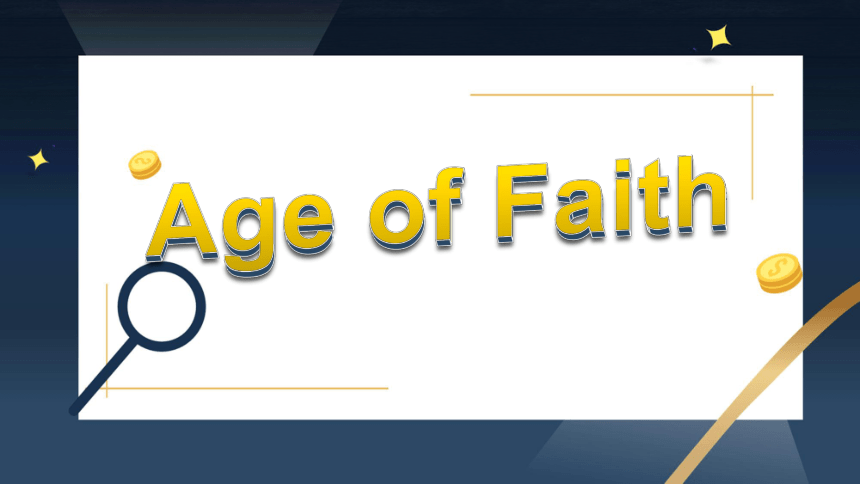
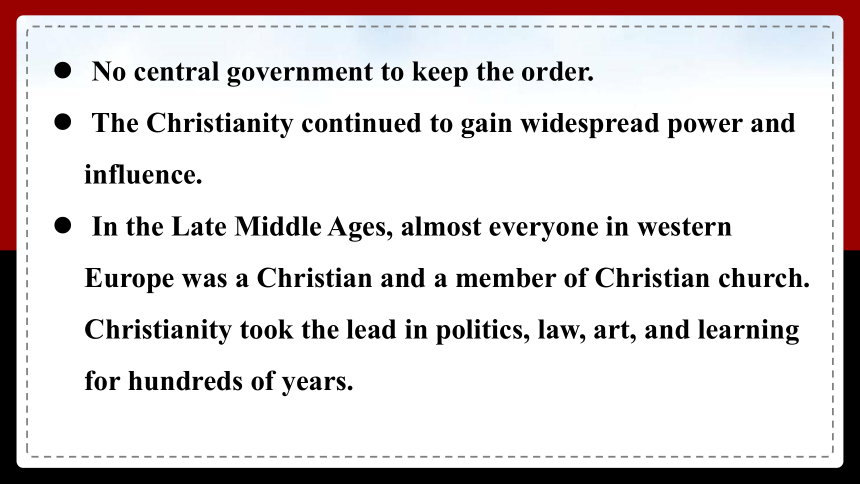
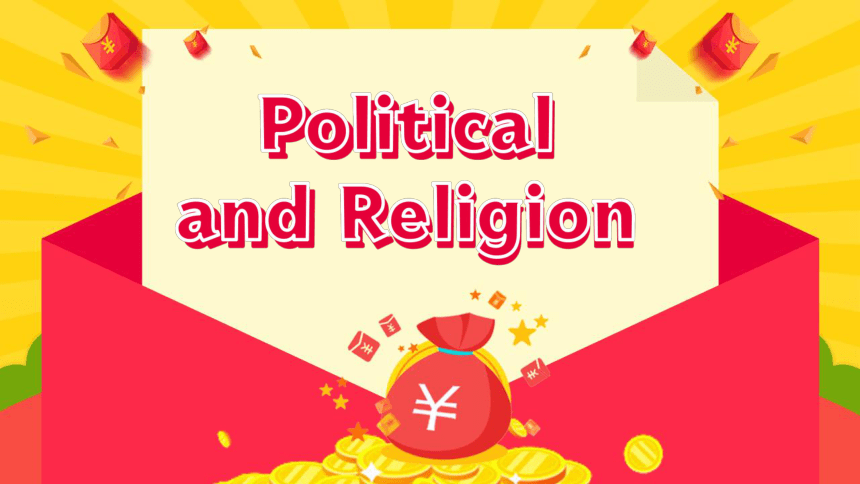

文档简介
(共50张PPT)
The Middle Ages
Definition
The Middle Ages: a period in European history from the collapse of the Roman Civilization in the 5th century AD to the period of the Renaissance in the 14th century
Interesting Stories
No Flat Earth Society
They knew it was round.
The ancients said it was round.
The fathers of the church said it was round.
Saw Earth’s shadow during eclipse and the shadow was round.
Middle Ages
Dark Bright
Cruel Brilliant
Dark Sides
Middle Ages is also called “Dark Ages”,
because after Uncivilized Germanics conquered the Rome, they made both people’s living standard and spiritual standard drop to a very low point. That’s a kind of “countermarch of civilization
Dark Ages
Age of Faith
No central government to keep the order.
The Christianity continued to gain widespread power and influence.
In the Late Middle Ages, almost everyone in western Europe was a Christian and a member of Christian church. Christianity took the lead in politics, law, art, and learning for hundreds of years.
Political
and Religion
Feudalism
1. The Manor (封建领主的)领地、庄园
2. Knighthood (骑兵身份)and code of Chivalry( 骑兵制度)
Religion
The organization of church
2.The power and influence of the Catholic Church
1.The Manor : The centre of medieval life under feudalism was the manor. Manors were founded on the fiefs(封地) of the lord(领主). Some lords owned only one manor; others owned many. They lived in manor houses. The manor house originally consisted of big rooms with a high ceiling and a straw-covered floor. By 12th century, manor houses were made of stone and designed as fortresses(堡垒). They came to be called castles. Medieval Europe was dotted with castles.
2. Knighthood and code of Chivalry
Almost all nobles in the Medieval days were knights
Code of Chivalry: As a knight, he was pledged to protect the weak, to fight for the church, to be loyal to his lord and respect woman of noble birth.
Pope(supreme head 教皇)
Archbishops (province大教主)
Bishops (diocese 主教)
Priests (parish 牧师)
The organization of church
The Power and Influence of the Catholic Church
Under feudalism, people of western Europe were mainly divided into three classes:
clergy, lords and peasants.
The Medieval Church was the centre of daily life in the country and town alike, and it had a part in all important events.
Slavery
serfdom 奴隶制: a social system of production in which labourers are bound to work for an estate, rather than being owned by the lord of that estate and could choose to work elsewhere though few would do so in reality
Penalty system
When the torture was executed, the suspect or defendant was tied to a wooden board supported by two parallel supports. He was put into a mouth with a horn and a 9 minute pint of water was slowly poured into the stomach of the suspect or defendant, and his nose was clamped to force it to swallow the water.
Water penalty
At that time, many people believed in Catholicism or Christianity. At that time, the social ethos believed that punishment was for atonement and that one's soul could be redeemed. In particular, if a person who has made a mistake can swallow boiling hot water or burning coal, he can clean his rotten soul and be blessed by God.
Cleaning the soul
The penalty is that craftsmen create a hollow copper ox with a door to let people in and out. Put the prisoner in, and then slowly heat the copper ox with fire. The prisoner inside makes a miserable sound. The cry is made by the specially treated mouth of the ox, which makes people outside sound like the sound of the cow.
Roast copper cattle
Laughing
The instrument is goat. The victim will bind his limbs to wooden shackles and tighten them tightly. Then honey or salt water was applied to the feet, and the goat keep touching it and the victim keep laughing until died.
plague
The 1940s and 1950s were a very miserable period for Europe. From 1347 to 1353, the plague swept across Europe, killing 25 million Europeans, accounting for one third of the total European population at that time. In the 20th century, it was comparable to the most tragic World War II in human history. The total number of people who died in the war in Europe was 5% of its population. Enough to see the plague to the people of Europe brought disaster. The plague has been described as "Black Death" in many literatures.
Brilliant
Sides
Universities
Medieval universities in Europe refer to the institutions of higher learning that emerged in European countries from the 11th century to the 17th century.
feature
1. It's a kind of scholar guild. The University of Bologna, a student-centered University, is made up of students of law studies in the city to protect their interests in the city. The University of Paris is teacher-centered.
2. These universities mainly include law, medicine, theology and later referred to as liberal arts. The curriculum is rather poor, mainly engaged in pure theoretical research divorced from social reality, which has no direct connection with social development.
3. It is closely related to religion. At that time, monks were learned people in society. The teaching content is full of scholasticism, which mainly seeks the basis for theology and doctrines, and propagandizes religion. It is an important duty of the university to train the clergy.
4. It enjoys a certain degree of autonomy. As an independent group outside the society, it has the right to manage its own internal affairs, including electing principals, arranging courses, hiring teachers and so on.
Architecture
It is an architectural style that flourished at the peak and end of the middle ages. It developed from Roman architecture and was inherited by Renaissance architecture. Originated in France in the 12th century and lasted until the 16th century, Gothic architecture is generally known as "Opus francisgenum" in contemporary times. The characteristics of Gothic architecture include pointed arch, rib vault and flying arch.
pointed arch, rib vault and flying arch
Arts
1. Early Christian Art
Early Christian art refers to the art of catacombs, about 100-420 A.D. It ended with Christianity being established as the national religion.
They can be roughly characterized as Basilica-plan and central-plan.
Characteristics:
Early buildings were only on walls and roof, decorated with murals and plaster relief, with few round carvings.
Most of the murals are drawn from the Bible, using symbolic expression techniques, omitting the details of the story, and conceptualizing and formulaizing the characters.
There are a lot of stories about Jesus, and they are shown as shepherds with no facial expression.
The style follows Rome, a little bitter and stiff.
Church of Saint Apollinare in Classe
Basilica-plan
2. Byzantine art
It refers to the capital of Roman Empire from Rome to Constantinople in 330, and until the Ottoman Empire will perish Byzantine Empire in 1453. Byzantine Empire is a religious and political Empire whose art is to glorify Christ and show his magic.
Contents:
influenced by early Christianity and restricted by traditions
most describe the Bible or Christianity
Styles:
decorative
lyricism
symbolic
Mathematic Achievements
A·M.S.
In general, his principles of arithmetic is the translation of introduction to arithmetic by Nicomachus, a mathematician of the new Pythagorean School, but some brilliant propositions have been deleted. His geometry is based on Euclid's original geometry, but there is no proof at all, because he thinks the proof is superfluous.
Fibonacci
He introduced the Indo Arabic numeral and digit system notation to Europeans, as well as the commercial application of various algorithms. The Chinese method of surplus and deficiency and the solution of indefinite equation in Sunzi Suanjing also appear in his book.
Nicole Oresme
He introduced the idea of fractional index notation and coordinate system, which is the transition from astronomy and geography longitude and latitude to modern coordinate geometry.
Thanks for your listening!
制作者:
The Middle Ages
Definition
The Middle Ages: a period in European history from the collapse of the Roman Civilization in the 5th century AD to the period of the Renaissance in the 14th century
Interesting Stories
No Flat Earth Society
They knew it was round.
The ancients said it was round.
The fathers of the church said it was round.
Saw Earth’s shadow during eclipse and the shadow was round.
Middle Ages
Dark Bright
Cruel Brilliant
Dark Sides
Middle Ages is also called “Dark Ages”,
because after Uncivilized Germanics conquered the Rome, they made both people’s living standard and spiritual standard drop to a very low point. That’s a kind of “countermarch of civilization
Dark Ages
Age of Faith
No central government to keep the order.
The Christianity continued to gain widespread power and influence.
In the Late Middle Ages, almost everyone in western Europe was a Christian and a member of Christian church. Christianity took the lead in politics, law, art, and learning for hundreds of years.
Political
and Religion
Feudalism
1. The Manor (封建领主的)领地、庄园
2. Knighthood (骑兵身份)and code of Chivalry( 骑兵制度)
Religion
The organization of church
2.The power and influence of the Catholic Church
1.The Manor : The centre of medieval life under feudalism was the manor. Manors were founded on the fiefs(封地) of the lord(领主). Some lords owned only one manor; others owned many. They lived in manor houses. The manor house originally consisted of big rooms with a high ceiling and a straw-covered floor. By 12th century, manor houses were made of stone and designed as fortresses(堡垒). They came to be called castles. Medieval Europe was dotted with castles.
2. Knighthood and code of Chivalry
Almost all nobles in the Medieval days were knights
Code of Chivalry: As a knight, he was pledged to protect the weak, to fight for the church, to be loyal to his lord and respect woman of noble birth.
Pope(supreme head 教皇)
Archbishops (province大教主)
Bishops (diocese 主教)
Priests (parish 牧师)
The organization of church
The Power and Influence of the Catholic Church
Under feudalism, people of western Europe were mainly divided into three classes:
clergy, lords and peasants.
The Medieval Church was the centre of daily life in the country and town alike, and it had a part in all important events.
Slavery
serfdom 奴隶制: a social system of production in which labourers are bound to work for an estate, rather than being owned by the lord of that estate and could choose to work elsewhere though few would do so in reality
Penalty system
When the torture was executed, the suspect or defendant was tied to a wooden board supported by two parallel supports. He was put into a mouth with a horn and a 9 minute pint of water was slowly poured into the stomach of the suspect or defendant, and his nose was clamped to force it to swallow the water.
Water penalty
At that time, many people believed in Catholicism or Christianity. At that time, the social ethos believed that punishment was for atonement and that one's soul could be redeemed. In particular, if a person who has made a mistake can swallow boiling hot water or burning coal, he can clean his rotten soul and be blessed by God.
Cleaning the soul
The penalty is that craftsmen create a hollow copper ox with a door to let people in and out. Put the prisoner in, and then slowly heat the copper ox with fire. The prisoner inside makes a miserable sound. The cry is made by the specially treated mouth of the ox, which makes people outside sound like the sound of the cow.
Roast copper cattle
Laughing
The instrument is goat. The victim will bind his limbs to wooden shackles and tighten them tightly. Then honey or salt water was applied to the feet, and the goat keep touching it and the victim keep laughing until died.
plague
The 1940s and 1950s were a very miserable period for Europe. From 1347 to 1353, the plague swept across Europe, killing 25 million Europeans, accounting for one third of the total European population at that time. In the 20th century, it was comparable to the most tragic World War II in human history. The total number of people who died in the war in Europe was 5% of its population. Enough to see the plague to the people of Europe brought disaster. The plague has been described as "Black Death" in many literatures.
Brilliant
Sides
Universities
Medieval universities in Europe refer to the institutions of higher learning that emerged in European countries from the 11th century to the 17th century.
feature
1. It's a kind of scholar guild. The University of Bologna, a student-centered University, is made up of students of law studies in the city to protect their interests in the city. The University of Paris is teacher-centered.
2. These universities mainly include law, medicine, theology and later referred to as liberal arts. The curriculum is rather poor, mainly engaged in pure theoretical research divorced from social reality, which has no direct connection with social development.
3. It is closely related to religion. At that time, monks were learned people in society. The teaching content is full of scholasticism, which mainly seeks the basis for theology and doctrines, and propagandizes religion. It is an important duty of the university to train the clergy.
4. It enjoys a certain degree of autonomy. As an independent group outside the society, it has the right to manage its own internal affairs, including electing principals, arranging courses, hiring teachers and so on.
Architecture
It is an architectural style that flourished at the peak and end of the middle ages. It developed from Roman architecture and was inherited by Renaissance architecture. Originated in France in the 12th century and lasted until the 16th century, Gothic architecture is generally known as "Opus francisgenum" in contemporary times. The characteristics of Gothic architecture include pointed arch, rib vault and flying arch.
pointed arch, rib vault and flying arch
Arts
1. Early Christian Art
Early Christian art refers to the art of catacombs, about 100-420 A.D. It ended with Christianity being established as the national religion.
They can be roughly characterized as Basilica-plan and central-plan.
Characteristics:
Early buildings were only on walls and roof, decorated with murals and plaster relief, with few round carvings.
Most of the murals are drawn from the Bible, using symbolic expression techniques, omitting the details of the story, and conceptualizing and formulaizing the characters.
There are a lot of stories about Jesus, and they are shown as shepherds with no facial expression.
The style follows Rome, a little bitter and stiff.
Church of Saint Apollinare in Classe
Basilica-plan
2. Byzantine art
It refers to the capital of Roman Empire from Rome to Constantinople in 330, and until the Ottoman Empire will perish Byzantine Empire in 1453. Byzantine Empire is a religious and political Empire whose art is to glorify Christ and show his magic.
Contents:
influenced by early Christianity and restricted by traditions
most describe the Bible or Christianity
Styles:
decorative
lyricism
symbolic
Mathematic Achievements
A·M.S.
In general, his principles of arithmetic is the translation of introduction to arithmetic by Nicomachus, a mathematician of the new Pythagorean School, but some brilliant propositions have been deleted. His geometry is based on Euclid's original geometry, but there is no proof at all, because he thinks the proof is superfluous.
Fibonacci
He introduced the Indo Arabic numeral and digit system notation to Europeans, as well as the commercial application of various algorithms. The Chinese method of surplus and deficiency and the solution of indefinite equation in Sunzi Suanjing also appear in his book.
Nicole Oresme
He introduced the idea of fractional index notation and coordinate system, which is the transition from astronomy and geography longitude and latitude to modern coordinate geometry.
Thanks for your listening!
制作者:
